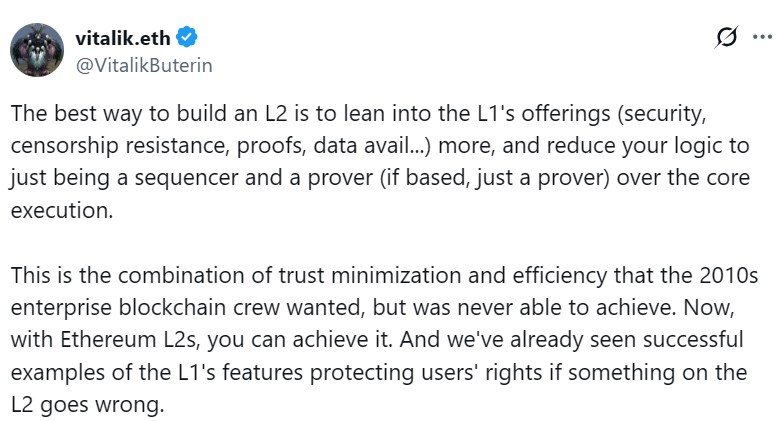As layer-1 networks face pressure to maintain relevance, Ethereum proponents suggest a new path forward: becoming a layer 2 on Ethereum.
On Monday, Jason Chaskin, who leads app relations and research at the Ethereum Foundation, sparked a conversation after saying that most layer 1s will become Ethereum layer 2s. He pointed to Celo’s recent transition as a blueprint.
Chaskin said Celo’s transition allowed the network to cut inflation, streamline its code, speed up block times and integrate itself into Ethereum, which he said has “the largest dev community in crypto.”
On Wednesday, Ethereum co-founder Vitalik Buterin joined the conversation, suggesting a path for those interested in building layer-2 networks.
Vitalik Buterin suggests a path for building L2s
Buterin echoed and expanded on the statement, saying the best way to build an L2 is to entirely rely on the strengths of Ethereum, which include security, data availability and censorship resistance.
He said that networks can reduce their logic to being a sequencer and a prover over the core execution.
Instead of reinventing the wheel and rebuilding everything, Buterin suggested that L2s can do as little as possible and focus on their sequencer, which decides the order of transactions, and its prover, which generates proof that transactions are valid and correctly executed.
Buterin said this approach achieves the “trust minimization and efficiency” enterprise blockchain builders in the 2010s sought but failed to deliver.
“Now, with Ethereum L2s, you can achieve it,” Buterin wrote. “And we’ve already seen successful examples of the L1’s features protecting users’ rights if something on the L2 goes wrong.”
Chaskin and Buterin’s remarks highlight a shift in approach for blockchain networks. As Ethereum strengthens its network, the duo suggests that the most strategic move might be to stop competing with Ethereum and start building on it.

Related: Ether holding $3K opens door to 1,100% ‘vertical phase’ rally: Analyst
Ethereum Foundation posts roadmap to zkEVM integration
Buterin’s comments come after the Ethereum Foundation announced a plan to integrate a zero-knowledge Ethereum Virtual Machine (zkEVM) into the network within one year.
On July 11, Sophia Gold, a developer in the Ethereum Foundation’s (EF) protocol support team, published a plan to replace traditional block execution within the network with zero-knowledge proofs (ZK-proofs).
With this, validators would only have to check ZK-proofs instead of re-running transaction blocks to verify them.
Magazine: TradFi is building Ethereum L2s to tokenize trillions in RWAs — Inside story















